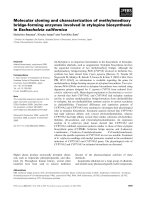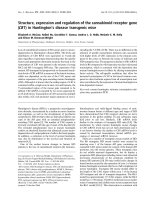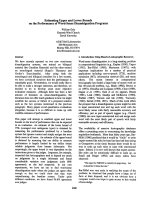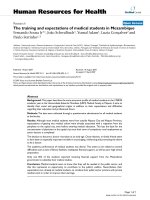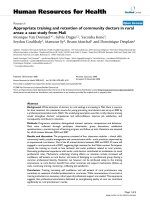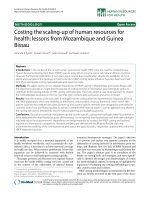Báo cáo sinh học: "Estimating rates and patterns of morphological evolution from phylogenies: lessons in limb lability from Australian Lerista lizards" ppsx
Bạn đang xem bản rút gọn của tài liệu. Xem và tải ngay bản đầy đủ của tài liệu tại đây (896.4 KB, 4 trang )
Minireview
EEssttiimmaattiinngg rraatteess aanndd ppaatttteerrnnss ooff mmoorrpphhoollooggiiccaall eevvoolluuttiioonn ffrroomm
pphhyyllooggeenniieess:: lleessssoonnss iinn lliimmbb llaabbiilliittyy
ffrroomm AAuussttrraalliiaann
LLeerriissttaa
lliizzaarrddss
John J Wiens
Address: Department of Ecology and Evolution, Stony Brook University, Stony Brook, NY 11794-5245, USA.
Email:
A major goal in evolutionary biology is to explain the great
phenotypic diversity of life. Why are there organisms that
look as varied as octopi, redwoods, earthworms, seagulls,
centipedes, jellyfish, and Scarlett Johansson? But in many
cases, understanding major changes in body form is difficult
because such dramatic changes have happened only rarely
and mostly in the distant past (for example, the remarkable
shell of turtles arose only once, and more than 200 million
years ago).
Enter the squamates (lizards and snakes). Within
squamates, one of the most dramatic changes in body form
in animals has occurred: from a four-limbed lizard-like
body plan to an elongate, limbless snake-like one. Although
everyone is familiar with snakes, a similar transition may
have occurred dozens of times and across many different
clades [1,2], sometimes among species of the same genus
[1]. As a model system for macroevolutionary research,
squamates offer both natural replication and controls (that
is, repeated changes in body form, sometimes among
closely related species).
Recent studies within squamates have begun to utilize
molecular phylogenies to reveal the patterns, rates, and
tempo of these dramatic changes in body form [2-5].
Because phylogeny is essential to understanding the ‘what
happened’ of evolution, these analyses represent the first
steps towards an integrative understanding of major
transitions in squamate body form. Molecular phylogenies
are particularly important, because phylogenetic analyses of
morphological data may be confounded by these dramatic
changes in body form [6], whereas molecular characters
should generally be unaffected.
Among all the many clades in which body form could be
studied, the Australian lizard genus Lerista may be the most
interesting. Lerista is one of only a few genera in which the
full range of these body forms is represented [1], from a
lizard-like body with well-developed limbs with five digits
(Figure 1a), to fully limbless forms with no external limbs
or digits (Figure 1c), with many seemingly intermediate
morphologies as well (for example, species with one to four
digits on a limb; Figure 1b). Past studies [7,8] have des-
cribed morphological variation in Lerista, but without a
phylogeny this variation is difficult to interpret evolutionarily.
Skinner et al. [9], in a study published in BMC Evolutionary
Biology, have now provided an extensive molecular phylogeny
AAbbssttrraacctt
Squamates (lizards and snakes) offer an exciting model system for research on the evolution
of body form. A new phylogenetic study in
BMC Evolutionary Biology
of Australian lizards
shows remarkable evolutionary lability in digit numbers among closely related species, but
also highlights important challenges in this area.
Journal of Biology
2009,
88::
19
Published: 24 February 2009
Journal of Biology
2009,
88::
19 (doi:10.1186/jbiol112)
The electronic version of this article is the complete one and can be
found online at />© 2009 BioMed Central Ltd
for Lerista, which they use to examine the evolution of digit
numbers. They have found some exciting results, but their
study also illustrates some important methodological
challenges. These challenges are not unique to the Lerista
study, but may affect many phylogeny-based studies of
character evolution. Here, I will briefly review what we have
learned from recent phylogenetic analyses of squamate
body-form evolution, and especially the new study of Lerista.
Past studies [2-4] have combined phylogenies with morpho-
metric and ecological data to show that there are really two
types of snake-like squamates. One is the long-tailed surface
dweller, in which much of the overall body length is tail,
and which often lives in dense grass. The other is the short-
tailed burrowing morph, which has a short tail, elongate
trunk, and typically lives underground. The long-tailed
morph has evolved five times, whereas the short-tailed
burrower has evolved at least twenty times. However, many
more origins of the burrowing morph remain to be docu-
mented among the ‘skinks’ (the common name for lizards
of the family Scincidae), given that skinks include many
limb-reduced taxa not yet included in phylogenies [2].
Kohlsdorf and Wagner [5] analyzed phylogeny and digit
evolution in the South American lizard genus Bachia and
found strong evidence that lost digits can be evolutionarily
regained. This is the sort of pattern that only a phylogeny
can reveal. However, a recent simulation study has raised
the possibility that some inferred reversals might be artifacts
of some likelihood-based reconstruction methods [10].
Brandley et al. [4] analyzed body form transitions across all
squamates (258 species sampled) using a phylogeny in
which the lengths of the branches reflect time (inferred using
modified molecular clock methods [11]). They found that
complete loss of external limbs seemed to require 16 million
years or more, but might be far more rapid. They also
showed that intermediate morphologies (for example, some
digits lost but not all) persist for long periods of time, in
some cases longer than the time needed for the transition
from fully limbed to fully limbless morphologies. This result
suggests that these seemingly intermediate morphologies are
not simply temporary transitions between extremes. They
also found some cases where lost digits seemed to re-evolve.
The new study by Skinner et al. [9] has reconstructed the
phylogeny of the pivotal skink genus Lerista, sampling 79%
of the 91 described species [12]. They also reconstructed
digit numbers (but not body form or limb loss) on their
tree using the statistical method of maximum likelihood.
Their results show remarkable evolutionary lability in digit
numbers. For example, they found clades of species with
five digits adjacent to those with none, species with no
digits (on the forelimb, or manus) at the base of the tree,
species with four digits deeply nested among species with
more extreme reduction (none to two), and seemingly four
separate instances of loss of all digits on both limbs. They
also used molecular-clock based time estimates to infer rates
of digit change, and claimed that transitions from five to no
19.2
Journal of Biology
2009, Volume 8, Article 19 Wiens />Journal of Biology
2009,
88::
19
FFiigguurree 11
Body form variation in
Lerista
. Three species of the Australian skink
genus
Lerista
are shown, illustrating the remarkable morphological
changes that have occurred within this genus, as elucidated in the new
paper by Skinner
et al
. [9]. (a) The species at the top (
Lerista microtis
)
has the typical lizard-like body form with five digits per limb, (b) the
species in the middle (
Lerista punctovittata
) has an intermediate body
form with reduced limbs whereas (c) the species at the bottom (
Lerista
ameles
) has the elongate snake-like body form and lacks external limbs
and digits. The photos of
L. microtis
and
L. punctovittata
are by Mark
Hutchinson and the photo of
L. ameles
is by Marco Sacchi.
(a)
(b)
(c)
digits can occur in 3.6 million years or less, much faster
than rates estimated by Brandley et al. [4] for other clades.
Although one might have predicted more rapid digit loss in
Lerista (they are congeners), the extreme lability of digit
evolution revealed by this new phylogeny is quite exciting.
However, this same lability may make it challenging to
reconstruct precisely what happened and how quickly. Their
reconstructions suggest multiple losses of digits from the
manus (hand) with no reversals (as expected), but they
found a very different pattern for the pes (foot). Using the
statistically best-fitting likelihood model for their pes data,
they found that digits were regained at a higher rate than the
rate at which digits were lost, implying that reacquisition of
lost digits is common (a remarkable result). Nevertheless,
they prefer reconstructions in which there are no reversals.
They argue that reconstructions with reversals are implausible
because some reconstructed ancestors have digital patterns
not seen in extant Lerista (for example, more digits on the
manus than pes). However, similar combinations do occur
in closely related taxa (for example, Anomalopus mackayi has
two digits on the forelimb and one on the hindlimb [4]),
and still occur under their favored model, only less fre-
quently. They also argue that the fit of models of evolution
in which reversals occur are not significantly different from
those in which they do not. Given the dramatic sensitivity
of the results to models that have statistically similar fit to
the data, it appears that the reconstructed patterns and rates
of digit loss and gain are actually quite uncertain, especially
for the pes. Previous authors have suggested that rapid rates
of character change may obscure past evolutionary history
and lead to uncertainty in reconstructions [13], and they
may create ambiguity in selecting models as well. Further-
more, the issue of character-state ordering (for example, is a
change from two digits to one treated as more likely than a
change from five to one?) was not addressed, but might also
be critical in accurately reconstructing the evolution of
characters that have multiple states, like digit number [4].
The inference of rates of change also requires some
additional caution. Inferring absolute rates of change from a
phylogeny requires reconstructing states on a tree with
estimated ages for each branch. Molecular analyses of
divergence times generally require calibration of clade ages
using one or more fossil taxa [11]. But these fossils can
generally only constrain the minimum age of a clade;
unsampled fossils can always show the clade to be older
[11]. Because no Lerista fossils are available, these authors
used fossils from a clade of distantly related skink taxa, but
did not address the possibility that this clade might be older
than indicated by the few available fossils. Coincidentally,
Brandley et al. [4] estimated ages of comparable Lerista
species using similar methods [11], but found them to be
nearly twice as old. If Lerista was twice as old, this would
mean that the rates of evolutionary change were actually
much slower. Clearly, there is considerable uncertainty in
estimating these ages, which may influence estimates of rates.
Estimates of evolutionary rates can also be sensitive to
character reconstructions. If the ancestral reconstructions
are ambiguous (as may be the case in Lerista), then it may
be difficult to say what the changes are, where they occur
on the tree, and how long they took to occur. Given that
Lerista is not extremely old and contains the full range of
digit numbers, there must have been rapid change. But
being more precise than this requires precise estimates of
ages and ancestral states. Perhaps the best approach for
future phylogeny-based studies of character evolution
would be to confront this uncertainty head on, and present
a range of estimated rates across different dates and
reconstruction models.
In summary, Skinner et al. [9] provide an invaluable
phylogeny for one of the most interesting groups of lizards for
the analysis of digit and body form evolution. But
paradoxically, Lerista may also prove to be quite difficult to
study, as character reconstructions seem ambiguous, rendering
precise inferences about rates or patterns of change somewhat
challenging. The rapid rate of digit evolution may be primarily
responsible for this ambiguity, and similar ambiguities may
plague other studies of rapidly evolving characters.
Phylogenetic studies are only the beginning of integrative
approaches to understanding evolution of body form in
living taxa. In addition to inferring the ‘what happened’ and
‘how quickly’, we also want to know the ‘why’ (for example,
functional consequences of different body forms) and the
‘how’ (for example, what genetic and developmental
mechanisms explain digit loss, limb reduction, and body
elongation). The phylogeny is not the final answer, but an
important initial step and a crucial framework for all future
evolutionary studies.
RReeffeerreenncceess
1. Lande R:
EEvvoolluuttiioonnaarryy mmeecchhaanniissmmss ooff lliimmbb lloossss iinn tteettrraappooddss
Evolu-
tion
1978,
3322::
73-92.
2. Wiens JJ, Brandley MC, Reeder TW:
WWhhyy ddooeess aa ttrraaiitt eevvoollvvee mmuull
ttiippllee ttiimmeess wwiitthhiinn aa ccllaaddee?? RReeppeeaatteedd eevvoolluuttiioonn ooff ssnnaakkee lliikkee bbooddyy
ffoorrmm iinn ssqquuaammaattee rreeppttiilleess
Evolution
2006,
6600::
123-141.
3. Wiens JJ, Slingluff JL:
HHooww lliizzaarrddss ttuurrnn iinnttoo ssnnaakkeess:: aa pphhyyllooggeenneettiicc
aannaallyyssiiss ooff bbooddyy ffoorrmm eevvoolluuttiioonn iinn aanngguuiidd lliizzaarrddss
Evolution
2001,
5555::
2303-2318.
4. Brandley MC, Huelsenbeck JP, Wiens JJ:
RRaatteess aanndd ppaatttteerrnnss iinn tthhee
eevvoolluuttiioonn ooff ssnnaakkee lliikkee bbooddyy ffoorrmm iinn ssqquuaammaattee rreeppttiilleess:: eevviiddeennccee
ffoorr rreeppeeaatteedd rree eevvoolluuttiioonn ooff lloosstt ddiiggiittss aanndd lloonngg tteerrmm ppeerrssiisstteennccee
ooff iinntteerrmmeeddiiaattee bbooddyy ffoorrmmss
Evolution
2008,
6622::
2042-2064.
5. Kohlsdorf T, Wagner GP:
EEvviiddeennccee ffoorr tthhee rreevveerrssiibbiilliittyy ooff ddiiggiitt
lloossss:: aa pphhyyllooggeenneettiicc ssttuuddyy ooff lliimmbb eevvoolluuttiioonn iinn tthhee ggeennuuss
BBaacchhiiaa
((GGyymmnnoopphhtthhaallmmiiddaaee:: SSqquuaammaattaa))
Evolution
2006,
6600::
1896-1912.
/>Journal of Biology
2009, Volume 8, Article 19 Wiens 19.3
Journal of Biology
2009,
88::
19
6. Lee MSY:
CCoonnvveerrggeenntt eevvoolluuttiioonn aanndd cchhaarraacctteerr ccoorrrreellaattiioonn iinn bbuurr
rroowwiinngg rreeppttiilleess:: ttoowwaarrddss aa rreessoolluuttiioonn ooff ssqquuaammaattee rreellaattiioonnsshhiippss
Biol J Linn Soc
1998,
6655::
369-453.
7. Greer AE:
LLiimmbb rreedduuccttiioonn iinn tthhee ggeennuuss
LLeerriissttaa
11 VVaarriiaattiioonn iinn tthhee
nnuummbbeerr ooff pphhaallaannggeess aanndd pprreessaaccrraall vveerrtteebbrraaee
J Herpetol
1987,
2211::
267-276.
8. Greer AE:
LLiimmbb rreedduuccttiioonn iinn tthhee ggeennuuss
LLeerriissttaa
22 VVaarriiaa
ttiioonn iinn tthhee bboonnee ccoommpplleemmeenntt ooff tthhee ffrroonntt aanndd rreeaarr lliimmbbss
aanndd tthhee nnuummbbeerr ooff ppoossttssaaccrraall vveerrtteebbrraaee
J Herpetol
1990,
2211::
142-150.
9. Skinner A, Lee MSY, Hutchinson MN:
RRaappiidd aanndd rreeppeeaatteedd lliimmbb
lloossss iinn aa ccllaaddee ooff sscciinncciidd lliizzaarrddss
BMC Evol Biol
2008,
88::
310.
10. Goldberg EE, Igic B:
OOnn pphhyyllooggeenneettiicc tteessttss ooff iirrrreevveerrssiibbllee eevvoolluu
ttiioonn
Evolution
2008,
6622::
2727-2741.
11. Sanderson MJ:
EEssttiimmaattiinngg aabbssoolluuttee rraatteess ooff mmoolleeccuullaarr eevvoolluuttiioonn
aanndd ddiivveerrggeennccee ttiimmeess:: aa ppeennaalliizzeedd lliikkeelliihhoooodd aapppprrooaacchh
Mol Biol
Evol
2002,
1199::
101-109.
12.
TThhee TTIIGGRR RReeppttiillee DDaattaabbaassee
[ />13. Schluter D, Price TD, Mooers AØ, and D. Ludwig D:
LLiikkeelliihhoooodd ooff
aanncceessttoorr ssttaatteess iinn aaddaappttiivvee rraaddiiaattiioonn
Evolution
1997,
5511::
1699-1711.
19.4
Journal of Biology
2009, Volume 8, Article 19 Wiens />Journal of Biology
2009,
88::
19
